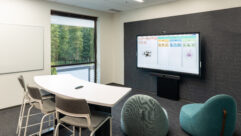
Spatial audio has been debated for some time as a mitigator for Zoom/Teams fatigue. In March, Microsoft teased that spatial audio was coming to Teams, and in April the feature debuted in public preview as part of an audio upgrade for Microsoft Teams Rooms, including Signature Teams Rooms. General release is expected to be mid-June.
Spatial audio within Teams requires USB-wired stereo headphones, laptop stereo speakers or external monitor stereo speakers. Bluetooth audio is not currently supported for spatial audio, but it soon will be, Microsoft claims. To experience this effect, the meeting must have more than two participants in gallery view. To preserve audio quality, Teams will turn off spatial audio if network bandwidth or computer memory is too low.
But while Microsoft has done its own foray into spatial audio, Pro AV veteran Q-SYS has brought the option on board in a more comprehensive way, also in collaboration with Microsoft. For systems utilizing certified Q-SYS audio, video, and control processing in Teams Rooms environments, users can now experience spatial audio allowing the audio of the remote participants to come from the direction of where the specific person talking is located on the screen, creating a more immersive and natural experience for in-room participants. Furthermore, the spatial audio feature with Teams Rooms can be supported at the software level via Q-SYS Designer Software, eliminating the need for additional hardware.
Q-SYS is a longtime participant in the Microsoft Teams Device certification program. Testing for this program is completed by an independent lab that operates many different tests depending on the device type and intended use. For audio systems, this includes a series of end-to-end tests of the complete audio signal chain. The lab runs a variety of system tests including Single Talk, Double talk, near and far end interrupt, latency, and HID functionality, just to name a few. The audio testing is completed in an anechoic chamber and a reverberant room with a battery of objective sound test and subjective listening exercises. After all the tests are completed the system is installed and evaluated in for two continuous weeks in a Microsoft testing location.
“Spatial audio support is yet another example of our growing partnership between Q-SYS and Microsoft to deliver features and solutions that elevate equitable collaboration experiences in high-impact spaces, including Signature Teams Rooms,” says Jason Moss, Vice President Corporate Development and Alliances, Q-SYS. “Because of the software architecture of Q-SYS, we can quickly adapt the Platform to offer this new feature.”
“We are pleased to continue innovating with Q-SYS to offer optimized solutions, like spatial audio, that enhance collaboration within Teams Rooms environments,” says Albert Kooiman, Senior Director of Microsoft Teams Devices Partner Engineering and Certification at Microsoft. “We are always looking for solutions to bridge the gap between people working remotely and those in the office, and with spatial audio, users can enjoy a richer meeting experience that can help reduce meeting fatigue.”










